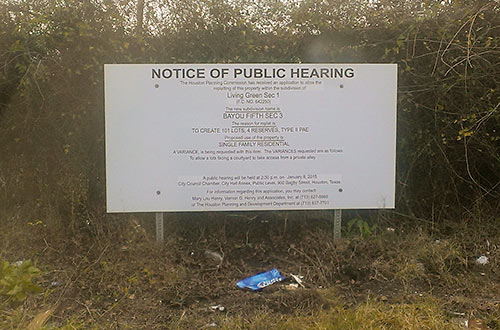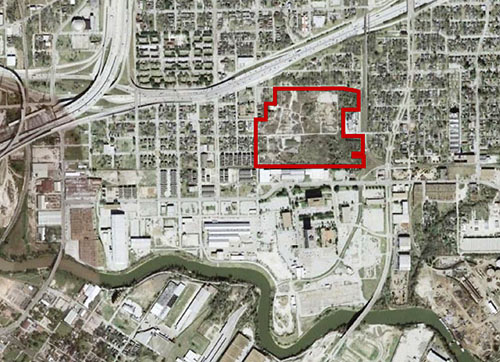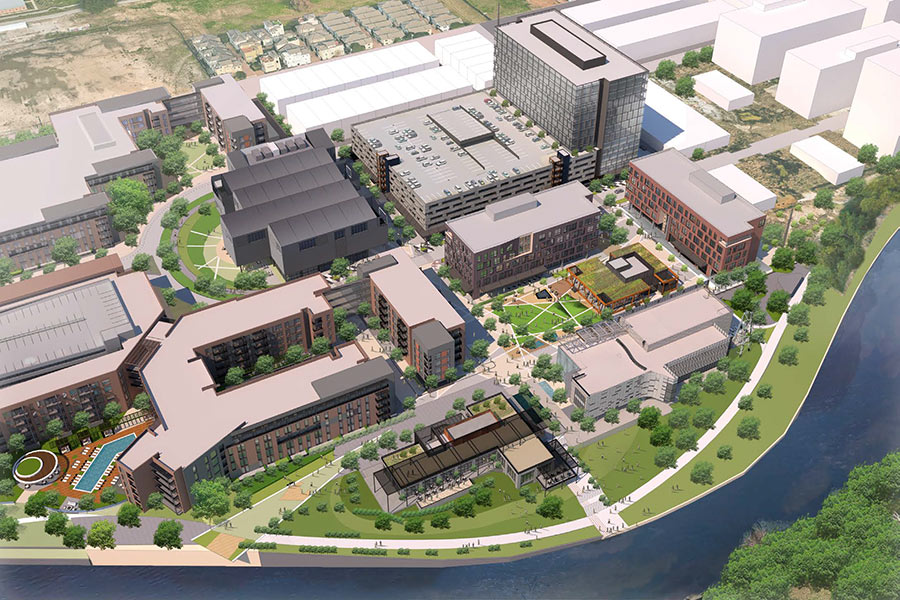
Signs have gone up around the former metal foundry site at 3617 Baer St. in the Fifth Ward indicating that a hearing is scheduled for this Thursday to get city approval for the latest rejiggering of homesites on the 35-acre tract. Developer Frank Liu of Lovett Homes, InTown Homes, and a few other local builder brands plans to put a total of 538 homes (down from 589) on the EPA-monitored property, known as the MDI Superfund Site after the last owner of the metal-casting operations, Many Diversified Interests, which shut down in the early 1990s (previously, the plants were owned by TESCO). The property, which lies just south of I-10 about 2 miles of east of downtown, was listed on the EPA’s list of priority Superfund sites in 1999, after tests showed the soil and groundwater was contaminated with lead and other hazardous metals.
***

Liu made news in 2005, when an entity under his control purchased the property at a bankruptcy auction for $7.9 million. The following year, his Clinton-Gregg Investments became the first non-liable party ever to sign an agreement to clean up a Superfund site, at a cost the EPA had estimated at $6.6 million.
Two of the 3 site approvals Liu’s Fenway Development is seeking from the planning commission this Thursday should be approved without discussion. The third, for the eastern portion of the site bounded roughly by Hare St., Press St., Harsfai Dr., and Clinton Dr., requires a variance. The application requests permission to allow lots facing an open space (unspecified on the application)Â to gain access from a private alley, and to “allow lot size and width averaging along each individual shared driveway.”
The variance should be granted, argues the applicant trying to convert a hazardous waste site into a housing development, because it “will promote the public welfare by helping to create environmental diversity within the neighborhood.” The developer is calling the project Living Green.
- The MDI Superfund Site and Houston’s Fifth Ward (PDF) [EPA]
- Many Diversified Interests, Inc. Superfund Site (PDF) [EPA]
- Previously on Swamplot:Â Fifth Ward: New Urbanists Meet Old Toxic Waste
Photos: Swamplot inbox (variance sign); EPA (aerial)





The timing might be unfortunate for this development if the local and overall economies contract, which could lead to a cutting of costs, scaling back of plans and an overall disappointing blob of homes.
Barring that, however, this should be a key cog in the gearing up of that area of the East End for a more interesting and inspiring future.
Nobody will buy a home on a ex superfund site no matter how clean the say the land is this is just a fail LOL
The name will be Bayou Fifth, not Living Green. Living Green was the previous name and will go away with this replat. Also, there is no variance for lot width averaging on Sec 3.
Living Green on a superfund site, love it.
Dana: I disagree. The land price in 5th ward will allow for home prices to be very low considering their proximity to downtown. This is the type of development that DOES make sense right now.
.
Brian: Someone looking to buy a first home, and live near downtown, won’t care about an “ex superfund” site. They’ll look at a low housing payment (lower than rent) and short commute times.
I dont think this will kick off as soon as everyone thinks. Re-Platting doesnt ensure immediate development. Plus, Frank has a pretty sweet deal on taxes for that site.
@ Brian D, you should see what some of the west side of town was built on top of. I trust the EPA to review and approve the site more that living on something without EPA approval in houston.
Fingers crossed for the “organic grid” design from 2007. That was a most excellent site plan.
It can never be cleaned up 100% and will always have a contamination disclosure attached to your deed. People who buy these homes must be desperate to live in the hood in the middle of cancer alley. Also some banks will not touch that property for mortgages.
Bayou Filth?
Brian D: Ever seen what happens after a death on a roller coaster? They paint it a new color, change the name, and people line up to ride.
You gotta be f*cking kidding me–on many levels.
A long but interesting read.
http://www.epa.gov/earth1r6/6sf/pdffiles/mdi-tx.pdf
One of the positives of a Superfund site is that there are easily accessible and copious public records on the site history, contamination, and cleanup. You know what you’re getting into.
Whereas if you buy on non-Superfund post-industrial land, you never know what you’re going to get, and what has been covered up.
Of course, Option C is don’t ever buy on former industrial sites at all.
I love the part where it says the project will “create environmental diversity'”. Yeah, people will be growing extra fingers and toes and glowing in the dark….
Well, who wouldn’t want to live on a superfun site. I mean…. oh wait. SuperFUND site.
I wouldn’t buy ANY property located on a “former” toxic dump site. I worked on an EPA Superfund case(Google Brio EPA Superfund site) and the residual long term chemical effects are scary and life threatening. No matter what the EPA na/or any developer /realtor says. Notice those parties are not buying any of that land.!
Land cost per townhome comes out to something like $14k doing simple math from the above. Liu can build cheap boxes and sell them for $200-300k to the hoards of people who want to live inside the loop, but are priced out of everything west of 45. At that price point, he will be competing directly with the cost of inner loop rental prices. With the tax benefit of claiming mortgage interest, you would get a better deal buying a townhome at the $200-300k. Houston’s economy would have to fall very hard and very far for Liu to lose money on this deal.
Commonsense got it mostly right, the biggest risk you face is the stigma and impacts to resale, but I think Cody is right, there will always be a fresh group of new arrivals that want to live in the loop but cannot afford the other side of downtown.
In terms of actual human health risk the site itself should ultimately be fine. EPA would not allow the use for residential if they didn’t think it was safe. It’s a metals site anyway, so as long as they pave it all or include engineered covers everywhere they want to keep Green, the exposure pathways should be closed. The bigger issue is air pollution related to proximity to other industry.
Construction will be interested. I wonder if the various contractors involved at the ground level will need HAZWOPR or other OSHA training/PPE.
If he’s just planting town homes with the plan of harvesting a quick profit, it’s basically replacing one toxic waste site for another.
_
With the acreage available, they have the space to make a real community of row houses with yards. A well designed home can get everything you need with half the square feet and still have huge closets and space for the things you actually do on a day to day basis.
Chemical analysis technologies have become so much more precise than they had been during the Brio cleanup, and the law is written in such a way that is open-ended in terms of what should constitute a “contamination”, that some folks that have invested in cleanup sites have found themselves in an absurd race against that technology if they ever want to get permission to build something. Therefore, yeah, I would feel at least as uncomfortable buying any other kind of urban land as buying land that has gone through formal cleanup procedures.
Even on a suburban lot in Bellaire — lets say — there’s really no telling what got illegally dumped there before Bellaire got developed and then there’s no telling what kind of nasty chemicals somebody had in their back shed in the 1960’s that they ended up pouring into the ground. That stuff will never get picked up as a red flag to warrant further investigation but that doesn’t mean that it isn’t there.
@Houstonian:
So, to rephrase: “The land is toxic, and the people that live there should have yards.”
“Houstonian” brings to mind an interesting thought. What would it take for us to return to the small house/big yard combo of bungalows or early suburban developments like Oak Forest?
I think you’d need trade restrictions.
All those developments came about when consumer durables were hard to come by. Think how much your average 50’s family scrimped and saved to get that color TV. But today I can walk into Fry’s and get a humongous LCD screen for a couple days’ pay, courtesy of any number of east/southeast Asian countries.
Since we all keep acquiring stuff, modern housing is now a cross between a living space and a mini-storage unit. This holds whether you’re buying a townhome in the Loop or a colonial in Fulshear. Liu is just showing us our revealed preferences.
oldschool, including the cleanup costs, the entire site costs 14.5 million (7.9 + 6.6). that’s a cost of $27k per home.
.
I think if he wants to go upscale he’ll wait at least a year (maybe 5-10) before he even thinks about getting started on building.
.
In the meantime, put in a driving range with a security guard in the parking lot.
As usual all you idiots on this site don’t live in the real world…what do you people think you live on now. Commonsense you are flat out wrong that there needs to be disclosure but then like most of the things you talk about you have little actual knowledge…this is great step forward for Houston and great for Cody to get it. Cody by the way one day I will actually use my real name and you will get a laugh about who I am…Lastly I always wonder how the people on these comments page have so much time to spend commenting…oh yeah it is because all of rest of us are out creating wealth and value and you are creating noise…
Too bad they’ve not elected to promote connectivity by extending Gillespie thru the site. Not doing such really restricts travel in the area. Gillespie already crosses the railroad tracks–it’s just this property missing a section that would make a great East-West local street. Greater access to the site would likely be a selling point if they were to extend Gillespie thru the site–this is the city after all, not the burbs. It’d be a shame to only have I-10 and Clinton Dr as East-West streets in the area. Opportunity missed.
This area needs a moniker with all the development ahead. How about the Buffalo Nickel?
@Mr. Developer – Must be your first time to the site. Commonsense is the “id” personality of swamplot. His comments are a mix of conservative dogma on goverment spending and suburban fear of the inner loop. I personally get a kick out his comments, otherwise this whole site would be a circle jerk with the same ideology.
500+ homes and no mixed use. This is what you call a bedroom community. If we cram 1000s of people into a small space and provide absolutely no
Mixed use component we’re forcing folks to get in their cars and drive! Way to go Frank.